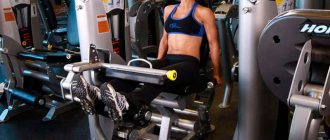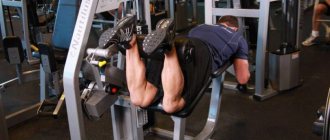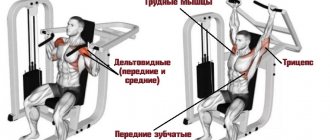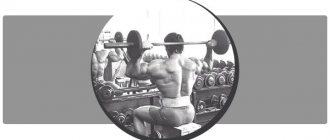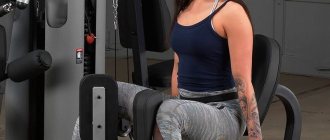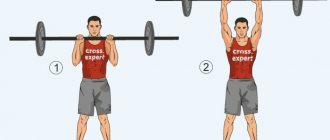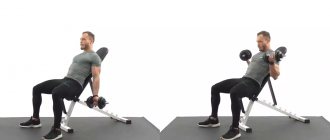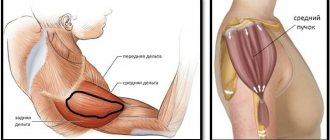In almost every gym, the free weights area is a mass gathering place for athletes. Here they patiently wait their turn to do the bench press, and strive to get a bar to pump up their shoulders in the standing press. Sometimes in such situations it is possible, without wasting time waiting, to perform a seated bench press in a special machine.
- Seated press in a simulator: training features
- Muscle activation in the seated press
- Benefits of Exercise
- Varieties of seated press: correct technique and significant nuances
- Bench press in a special machine
- Video: Technique for performing seated bench presses in a machine
- Hammer Seated Press
- Video: How to properly perform a bench press in a Hummer
- Smith machine press to work the pectoral muscles
- Press sitting in front of you at an angle in the Smith machine
- Video: Press sitting in a Smith machine in front of you - pumping up the chest and shoulder muscles
- Smith machine overhead press
- Video: Correct technique for performing seated overhead presses in a Smith machine
- Recommendations for performing the exercise effectively
Which exercise machine should I use?
Let us explain that the choice of a simulator (or let us agree that we will henceforth talk about the angles of the force vector relative to the floor) depends on what muscles you want to pump.
We recommend reading: Leg exercises at home for girls
In this article we will take an overview of the most important techniques in various simulators:
- To pump up your chest, you need to choose a machine that simulates a bench press. Usually this is a device with a seat and a backrest at right angles to it. The handles that will need to be pushed away from you (press) are located at the level of the bottom of the chest. The exercise is more similar to a reverse grip press, although the palms are in a straight position.
- To work the shoulders you will need a hammer and a Smith machine. In a Hummer you can pump up the front deltoids. This is a good option after the classic bench press and incline press.
- In Smith, you can do presses at different angles, as well as a seated barbell press (when you press it vertically up, bringing it behind your head or onto your chest).
Thus, the choice of a simulator will directly depend on what you want to train today. And, of course, it depends on what kind of exercise equipment is available in the gym you come to.
Equipment
To perform a chest press in a machine, you will need sports gloves, an elastic bandage for the elbows or wrists, and comfortable shoes with non-slip soles. The first piece of equipment will allow you to hold the handles tightly. This is especially important when working with heavy weights, when the risk of accidentally letting go of them increases.
The second element is even the ability to protect weak joints from damage. However, if an athlete has already had a shoulder or elbow joint injury, then it is not recommended for him to exercise on such a simulator.
Advantages and disadvantages of the chest press
Advantages
- Isolated work of the pectorals with less involvement of the stabilizer muscles.
- The ability to work on each side separately. This will lead to a reduction in developmental imbalances.
- It is safe to perform bench presses on the machine. Even if you can't press the weight for one more rep, it still won't crush you. How this can happen when working with a barbell. Therefore, it becomes possible to work to failure without the help of a belayer.
- The load on the shoulder muscles, especially on the anterior bundles, is much less. Than when working with free weights (barbell, dumbbells).
- Makes it possible to finish off the pectoral muscles at the end of the workout (pumping). That is, the muscles are filled with blood and oxygen. Which contributes to better recovery after strength training.
- You can work with quite a lot of weight. Of course, the main thing is not to overdo it.
- Performing bench presses in the simulator occurs at a very large amplitude. Therefore, we can properly stretch the muscles at the lowest point.
- Ability to work with heavy weights in the eccentric phase (lowering the weight). This will trigger new stress and hormone production. Giving impetus to muscle growth.
As you can see, bench press in the simulator will help you get out of stagnation. This is especially true for professional athletes.
Flaws
- The bench press cannot replace basic exercises in terms of effectiveness.
- For some athletes, the vector set by the simulator may not be anatomically convenient. Consequently, they will not be able to develop the full potential of the pectoral muscles. Fortunately, such cases do not occur so often.
Basic exercises will always be most effective if our goal is to build muscle mass. But if we are talking about detailing the muscles and giving them shape. This is where isolated exercises come into play. Which includes the bench press in the simulator. Therefore, this drawback will be relevant only if we want to increase mass with the help of this exercise.
Description of the exercise
Can be considered as an addition to the bench press, but in no case as a replacement. After all, the barbell press is a basic exercise, and the bench press in a chest machine is an addition and can be performed either at the end of a workout or after basic chest exercises.
When you press the weight up, do not move your shoulders forward by inertia, rest them against the back of the machine and do not lift them off until the end of the exercise. Pay special attention to machines that move in a triangular direction, that is, when lowering, the arms are spread wide, and when squeezing, the weights are brought together in front.
Exercises for pumping chest muscles
All chest muscles can be roughly divided into three parts - upper, middle and lower. Each part is better stimulated depending on the change in angle at which you perform the exercise.
- For the upper part, exercises performed on a bench at an upward angle of 30-45% are best suited.
- For the middle part, exercises performed on a flat bench are best.
- For the lower part, exercises performed on a bench at a downward angle of 30-45% are best suited.
All chest exercises must be performed with perfect form because poor form can become a habit that will lead to lack of progress or worse, injury in the future. The following are exercises you can do to train your chest muscles, and a step-by-step guide will help you achieve perfect technique.
What muscles are involved?
Let us immediately note that the main muscles involved are the pectoralis major and minor. These groups are the focus when working with block weight simulators. Hummers are the most popular, but there are other proven mechanisms. In addition to breasts, you can develop:
- shoulders (back, middle, front deltas);
- lateral triceps bundles;
- medium and long triceps bundles;
- serratus anterior abdominal muscle.
Important! The exercise is considered isolated and allows you to work out the pectoral muscles as much as possible. This should be taken into account when building your training program.
Seated press machine
Don’t forget to do a good warm-up and warm up your joints. Next, hang a small weight on the machine (20–30 kg is enough for men, 1–5 kg for girls – depending on physical fitness). This will be a warm-up approach.
We recommend reading: Transverse abdominis exercises
- If the simulator has the option of adjusting the seat and back, adjust everything to suit you. You need to sit on the simulator chair, pressing your body tightly against the back. If your lower back is far from it, this is the wrong position.
- Sit down and bend your lower back forward, straighten your shoulders, take a deep breath and exhale. Get ready to breathe correctly: exhale during the push, inhale when returning to the starting point.
- Grasp the handles so that you are comfortable. If the machine has an auxiliary pedal for lifting weights, press it with your foot - this will help raise the handles to the starting position. If this is not provided, lift the weight with your arms.
- Push the handles with the strength of your pecs, shoulders and triceps, exhaling. Now lower the weight back down while inhaling. You can’t hold your breath, don’t forget about it!
- Repeat the movement 10–15 times without haste, thoughtfully. This was a warm-up approach.
Now set the desired weights and do 8-12 repetitions in 3-4 sets, or in other combinations, depending on your program.
Seated Angle Press
This exercise is almost identical to the classic bench press in a seated machine. However, the machine in which it is performed has an incline bench, which allows you to better focus on the upper part of the pectoral muscles.
- Start by adjusting the seat of the bench so that the arms of the machine are in line with your upper chest. Also set the appropriate load. Sit on a bench and grab your hands. This will be your starting position.
- As you inhale, begin to slowly push the handles of the machine forward until your arms are fully extended. You should feel a stretch in your pectoral muscles. Hold this position for a couple of seconds and then slowly return to the starting position.
- Do the recommended number of repetitions.
Seated bench presses on the pectoral muscles will allow you to effectively work out your muscles. Do 3 sets of 10-12 reps, resting 45 seconds between sets.
A little about body structure
A special feature of the large muscles of the chest is its fan-shaped shape. The fibrous part of this part of the musculature is smoothly distributed from the point of attachment to the humerus of the bone. By its structure, this chest muscle is connected to the front of the chest, but in practice its main task is to help the bones of the shoulder joint. This suggests that to quickly and efficiently build a chest, bending your arms at the shoulders is required.
The location of the large muscle is on the front of our chest. The unifying fiber acts as a “blanket”, which seems to envelop the muscles. Its name is pectral fascia. The large muscle has two heads:
- clavicular - located along the clavicular head and fixed to the ribs. These muscles do not play a special role in building the chest muscles;
- The sternocostal group is fixed to the upper lobe of the sternum. It also has several fibers that attach to the external abdominal muscles.
When performing a classic bench press, you engage both heads. In the case of working out the pectoral muscles on the simulator, the sternocostal head receives the greatest load.
Hummer Seated Press
The hammer simulates a barbell or dumbbell press at different angles, usually 45 and 60 degrees. This machine will help you pump up your upper chest and front deltoids.
It has a device (pedal) for bringing the weight to the starting position. Use light weights for warming up.
- Adjust the seat height so that in the initial position the handles of the hummer are at the level of your shoulders, and your arms do not “twist” back. If the seat is too low, your elbows will be extremely far back. It is very difficult to start a repetition from such a position.
- Help lift the weight with your foot by pressing the special pedal.
- After the handles have returned to the starting position, squeeze them out with your hands (you don’t have to straighten your arms completely so that the elbow joints don’t snap into place - leave a slight angle between the forearm and shoulder).
- Lower the weight back to a physiologically comfortable position. Repeat this movement 10-15 times – the warm-up is complete. As you climb, don’t forget to exhale through your mouth. Inhale through your nose while lowering the weight.
- Help lower the weight to its original position using a special pedal.
Set the working weight and do 8-10 repetitions in 3-4 sets.
Seated dumbbell raises
Many experienced bodybuilders consider the seated dumbbell press exercise to be the best core exercise for pumping up the shoulder muscles. In this action, you will be pleased with the large amplitude that loads the delta areas.
This exercise allows you to take on large weights. Before training, you need to warm up thoroughly.
The training steps are as follows:
- First, you should set the angle of the bench, which should be 60-90 degrees.
- Place the dumbbells on the floor and sit on a bench.
- Having made a small jerk, the dumbbells are thrown to shoulder level. This will become the starting position.
- Exhaling, raise your arms until the dumbbells are near each other in the upper segment, but you must not allow them to touch.
- Slowly lower the dumbbells, while spreading your elbows to the sides, bringing the projectile to the line of your earlobes.
- You need to contract your shoulders in the lower position and raise the dumbbells up again, the shoulders contracting in the upper position.
- Repeats are done as many times as necessary.
During this action, it is important to make sure not to hit the dumbbells in the upper position, because this will remove the load from the deltoids.
Seated Angle Press and Smith Machine
Place an incline bench under the bar of a Smith machine. Position it so that when you lie down on the bench, the bar is level with the middle of your pecs. Set the back angle to 45 degrees. This position is also called “sitting”. There is no need to hang anything yet; initially the bar weighs 20–25 kg, which is just right for warming up.
- Sit on a bench, press the top of your buttocks to the bottom of your back. Bend your lower back forward, squeeze your shoulder blades together, straighten your shoulders. Press the back of your head against the back of the bench.
- Grasp the bar with a wide grip (palms wider than shoulder width). Usually there are risks on the fingerboard that you should follow. You can do this: find the marks located closer to the edges of the fingerboard and place your ring or middle fingers on them. This makes it easier to achieve a symmetrical grip. By the way, the grip is straight.
- Remove the bar by twisting it to remove the clamps.
- Gently lower it onto your chest. The bar should be located between the shoulders and the pectoral muscle. This is the correct position. Lower it as far as possible, stretching the front deltoids and pectoral muscles.
- Lift up as you exhale, repeat 10–15 times. The warm-up is over.
Now set the desired weights and do 8-10 repetitions in 3-4 sets. If you can't squeeze out the last reps, rotate the bar in a critical position: it will lock. Or ask a friend (coach) to back you up.
We recommend reading: A kilogram of fat and a kilogram of muscle
There is a nuance - for some it is convenient to turn the bar away from you, for others - towards you. Experiment with how it is more convenient for you to do this. Because at the critical moment, when you need to fix the barbell, you may not succeed. That is, if turning in one direction is inconvenient for you, turn the bench 180 degrees.
Execution technique
There are many technical nuances. This exercise is not performed correctly by the vast majority. People start to press with their shoulders raised, and all because they don’t know how to bring the dumbbells to their shoulders correctly
So, to press dumbbells while sitting, you need:
- Arrange them so that you can do sit-up hip raises from the floor, that is, place dumbbells on your hips, holding them with your hands;
- Use your feet to push the weights toward your shoulders;
- Spread your elbows so that the dumbbell bars are in a plane parallel to the floor;
- The press itself begins with lowering your elbows down and placing your forearms perpendicular to the floor;
- At the same time, it is recommended to bring the shoulder blades together and lower them down to the pelvis;
- A slight deflection in the lumbar spine is allowed, but there is no need to emphasize it;
- By engaging the shoulder and triceps muscles, the dumbbells are pulled up;
- The elbows are extended in a plane perpendicular to the floor; it is not recommended to “mow” them forward or backward;
- Lower the dumbbells to your shoulders and perform the required number of repetitions
This exercise is performed first with warm-up weights, then with working weights. There is no need to rush or try to push the weight away from you so that the dumbbells go forward. If heavy weights are used, you can use an athletic belt, just enough to remove excess mobility in the lumbar spine.
Exercises for shoulders. Seated dumbbell press.
Hand curls in the simulator
To train your chest, it is important to combine two types of movements: compression and deep stretching. The hand pinch machine helps you do both of these. The butterfly exercise (peck-deck) is an isolating exercise that allows you to strongly compress the chest muscles and then stretch them in a negative phase.
- Set the weight that suits you. Your shoulders should be parallel to the floor, so adjust the machine accordingly. Sit with your back resting on the exercise pad. Take your pens. This will be your starting position.
- As you exhale, slowly begin to bring your arms together, squeezing your chest muscles. Hold the contraction for a second at the peak point. As you inhale, return under control to the starting position until your pectoral muscles are fully stretched.
- Do the recommended number of repetitions.
A good training option would be to combine hand presses in a machine with push-ups. Once you complete 20 reps, move on to 20 push-ups. Perform 3 supersets in this manner, taking a 60-second break between exercises.
Technique for exercising with dumbbells while lying down
- You should take the dumbbells in your hands and support them with a neutral grip (palms facing you), then sit down on the bench. Next, the dumbbells are placed on your legs closer to your knees, and you should lean back, at the same time throwing the weight over your chest. At the beginning, it is worth unfolding the dumbbells in a single line so that they are on both sides of the chest, level with the collarbones. The legs rest on the floor, the lower back bends;
- As you exhale, with smooth movements without sudden movements, the dumbbells rise to the top. In the upper position, you need to linger for a few seconds, tense your chest muscles and lower the dumbbells to the floor more slowly than you did the lifting. Slowly place the projectile in its original position.
Before doing exercises, it is important to warm up to prepare the body for heavy loads.
Mistakes in training the pectoral muscles
The two biggest mistakes most people make in their training are:
- Focusing on the wrong exercises. Many people pay excessive attention to machines and isolation exercises, which have a secondary role in creating impressive muscle mass in the chest muscles.
- Lots of repetitions. Repeated training will only tone the muscles, but not build them.
The more you perform compound movements with heavier weights (80-85% of your maximum and above), the better your results will be.
Preparation
This is a mandatory part of the exercise. In addition to warming up, before starting the main part, it is necessary to do a warm-up.
To do this, use less weight than the worker, and perform a classic bench press; on a board with an upward slope or rotation of the shoulder joints outward and inward, while warming up the elbows and wrists, you can perform pull-ups.
Tips for maximum efficiency
- Before starting your workout, do a set of warm-up exercises. Focus on your shoulders and pectoral muscles.
- If you experience discomfort in your shoulder and elbow joints while doing a bench press, it means you have not adjusted the height of the machine correctly.
- When working with heavy weights, use the help of a training partner. It will help move the handles from the starting position to the starting position. Some block exercise machines have a special pedal installed for this purpose.
- To protect your wrists, you can use wrist wraps.
- Do not lift your legs while performing the exercise. This will cause the torso to twist and may cause spinal injury.
- The exercise should be performed in the average range from 12 to 15 times. Provided that the last two repetitions will be difficult for you.
- Be sure to perform at least 1 warm-up set with light weight.
As you can see, the exercise requires special attention to execution technique. Yes, working in a machine is safer than using free weights. But this does not mean that you can do whatever you want. Therefore, be sure to warm up before training, work on your technique and avoid mistakes. And then your results will constantly improve.
Calculate your ideal sports weight!
Safety
When performing a seated chest press, it is important to only work with your optimal weight. It is not recommended to use blocks that are too heavy, as they can significantly complicate the exercise and lead to strain on the mobile shoulder joints. You need to squeeze the handles smoothly, slowly, so that the muscles can feel the load well.
It is also important to keep your feet firmly pressed to the floor surface . They should not be torn off so that the load does not go from the chest to the back. The entire foot should be level on the floor, since only in this position the weight is smoothly distributed over it.
There is no need to lift your shoulders and lower back from the back of the machine . Any distortion of posture can lead to the fact that the back begins to strain more, and the chest will not be able to feel the level of load that was planned. In addition, the formation of a deflection in the lower back is fraught with pain and injury.
